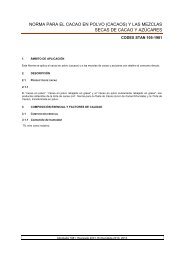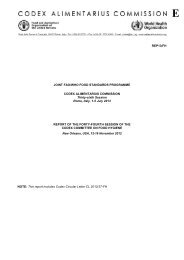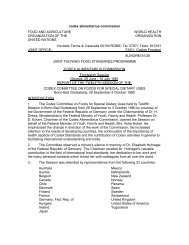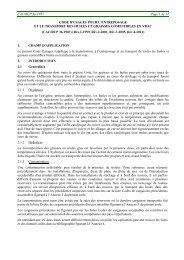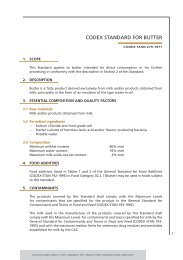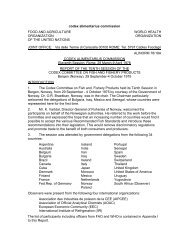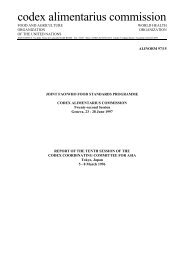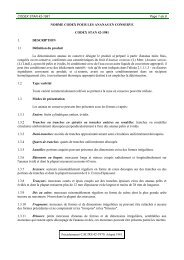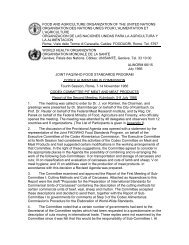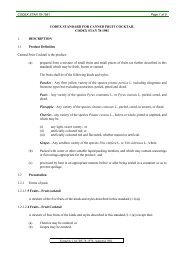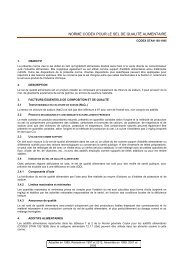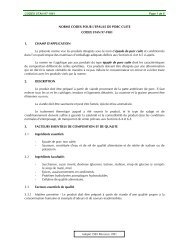Standard for Named Vegetable Oils - CODEX Alimentarius
Standard for Named Vegetable Oils - CODEX Alimentarius
Standard for Named Vegetable Oils - CODEX Alimentarius
You also want an ePaper? Increase the reach of your titles
YUMPU automatically turns print PDFs into web optimized ePapers that Google loves.
<strong>CODEX</strong> STAN 210-1999 Page 1 of 16<br />
<strong>CODEX</strong> STANDARD FOR NAMED VEGETABLE OILS<br />
<strong>CODEX</strong> STAN 210-1999<br />
The Appendix to this <strong>Standard</strong> is intended <strong>for</strong> voluntary application by commercial partners and not <strong>for</strong><br />
application by governments.<br />
1. SCOPE<br />
This <strong>Standard</strong> applies to the vegetable oils described in Section 2.1 presented in a state <strong>for</strong> human<br />
consumption.<br />
2. DESCRIPTION<br />
2.1 Product definitions<br />
(Note: synonyms are in brackets immediately following the name of the oil)<br />
2.1.1 Arachis oil (peanut oil; groundnut oil) is derived from groundnuts (seeds of Arachis hypogaea L.).<br />
2.1.2 Babassu oil is derived from the kernel of the fruit of several varieties of the palm Orbignya spp.<br />
2.1.3 Coconut oil is derived from the kernel of the coconut (Cocos nucifera L.).<br />
2.1.4 Cottonseed oil is derived from the seeds of various cultivated species of Gossypium spp.<br />
2.1.5 Grapeseed oil is derived from the seeds of the grape (Vitis vinifera L.).<br />
2.1.6 Maize oil (corn oil) is derived from maize germ (the embryos of Zea mays L.).<br />
2.1.7 Mustardseed oil is derived from the seeds of white mustard (Sinapis alba L. or Brassica hirta<br />
Moench), brown and yellow mustard (Brassica juncea (L.) Czernajew and Cossen) and of black mustard<br />
(Brassica nigra (L.) Koch).<br />
2.1.8 Palm kernel oil is derived from the kernel of the fruit of the oil palm (Elaeis guineensis).<br />
2.1.9 Palm kernel olein is the liquid fraction derived from fractionation of palm kernel oil (described<br />
above).<br />
2.1.10 Palm kernel stearin is the solid fraction derived from fractionation of palm kernel oil (described<br />
above).<br />
2.1.11 Palm oil is derived from the fleshy mesocarp of the fruit of the oil palm (Elaeis guineensis).<br />
2.1.12 Palm olein is the liquid fraction derived from the fractionation of palm oil (described above).<br />
2.1.13 Palm stearin is the high-melting fraction derived from the fractionation of palm oil (described<br />
above).<br />
2.1.14 Palm superolein is a liquid fraction derived from palm oil (described above) produced through a<br />
specially controlled crystallization process to achieve an iodine value of 60 or higher.<br />
2.1.15 Rapeseed oil (turnip rape oil; colza oil; ravison oil; sarson oil: toria oil) is produced from seeds of<br />
Brassica napus L., Brassica rapa L., Brassica juncea L. and Brassica tourne<strong>for</strong>tii Gouan species.<br />
2.1.16 Rapeseed oil - low erucic acid (low erucic acid turnip rape oil; low erucic acid colza oil; canola<br />
oil) is produced from low erucic acid oil-bearing seeds of varieties derived from the Brassica napus L.,<br />
Brassica rapa L. and Brassica juncea L., species.<br />
2.1.17 Rice bran oil (rice oil) is derived from the bran of rice (Oryza sativa L).<br />
2.1.18 Safflowerseed oil (safflower oil; carthamus oil; kurdee oil) is derived from safflower seeds (seeds<br />
of Carthamus tinctorious L.).<br />
Adopted 1999. Revisions 2001, 2003, 2009. Amendment 2005, 2011, 2013.
<strong>CODEX</strong> STAN 210-1999 Page 2 of 16<br />
2.1.19 Safflowerseed oil - high oleic acid (high oleic acid safflower oil; high oleic acid carthamus oil;<br />
high oleic acid kurdee oil) is produced from high oleic acid oil-bearing seeds of varieties derived from<br />
Carthamus tinctorious L.<br />
2.1.20 Sesameseed oil (sesame oil; gingelly oil; benne oil; ben oil; till oil; tillie oil) is derived from sesame<br />
seeds (seeds of Sesamum indicum L.).<br />
2.1.21 Soya bean oil (soybean oil) is derived from soya beans (seeds of Glycine max (L.) Merr.).<br />
2.1.22 Sunflowerseed oil (sunflower oil) is derived from sunflower seeds (seeds of Helianthus annuus L.).<br />
2.1.23 Sunflowerseed oil - high oleic acid (high oleic acid sunflower oil) is produced from high oleic acid<br />
oil-bearing seeds of varieties derived from sunflower seeds (seeds of Helianthus annuus L.).<br />
2.1.24 Sunflowerseed oil - mid oleic acid (mid-oleic acid sunflower oil) is produced from mid-oleic acid<br />
oil-bearing sunflower seeds (seeds of Helianthus annuus L.).<br />
2.2 Other definitions<br />
2.2.1 Edible vegetable oils are foodstuffs which are composed primarily of glycerides of fatty acids being<br />
obtained only from vegetable sources. They may contain small amounts of other lipids such as phosphatides,<br />
of unsaponifiable constituents and of free fatty acids naturally present in the fat or oil.<br />
2.2.2 Virgin oils are obtained, without altering the nature of the oil, by mechanical procedures, e.g.<br />
expelling or pressing, and the application of heat only. They may have been purified by washing with water,<br />
settling, filtering and centrifuging only.<br />
2.2.3 Cold pressed oils are obtained, without altering the oil, by mechanical procedures only, e.g.<br />
expelling or pressing, without the application of heat. They may have been purified by washing with water,<br />
settling, filtering and centrifuging only.<br />
3. ESSENTIAL COMPOSITION AND QUALITY FACTORS<br />
3.1 GLC ranges of fatty acid composition (expressed as percentages)<br />
Samples falling within the appropriate ranges specified in Table 1 are in compliance with this <strong>Standard</strong>.<br />
Supplementary criteria, <strong>for</strong> example national geographical and/or climatic variations, may be considered, as<br />
necessary, to confirm that a sample is in compliance with the <strong>Standard</strong>.<br />
3.1.1 Low-erucic acid rapeseed oil must not contain more than 2% erucic acid (as % of total fatty acids).<br />
3.1.2 High oleic acid safflower oil must contain not less than 70% oleic acid (as a % of total fatty acids).<br />
3.1.3 High oleic acid sunflower oil must contain not less than 75% oleic acid (as % of total fatty acids).<br />
3.3 Slip point<br />
Palm kernel olein<br />
Palm kernel stearin<br />
Palm olein<br />
Palm stearin<br />
Palm superolein<br />
4. FOOD ADDITIVES<br />
between 21 to 26 °C<br />
between 31 to 34 °C<br />
not more than 24°C<br />
not less than 44°C<br />
not more than 19.5°C<br />
4.1 No food additives are permitted in virgin or cold pressed oils.<br />
4.2 Flavours<br />
Natural flavours and their identical synthetic equivalents, and other synthetic flavours, except those which<br />
are known to represent a toxic hazard.
<strong>CODEX</strong> STAN 210-1999 Page 3 of 16<br />
4.3 Antioxidants<br />
INS No. Additive Maximum Use Level<br />
304 Ascorbyl palmitate<br />
305 Ascorbyl stearate<br />
500 mg/kg (Singly or in combination)<br />
307a Tocopherol, d-alpha-<br />
307b Tocopherol concentrate, mixed<br />
300 mg/kg (Singly or in combination)<br />
307c Tocopherol, dl-alpha<br />
310 Propyl gallate 100 mg/kg<br />
319 Tertiary butyl hydroquinone (TBHQ) 120 mg/kg<br />
320 Butylated hydroxyanisole (BHA) 175 mg/kg<br />
321 Butylated hydroxytoluene (BHT) 75 mg/kg<br />
Any combination of gallates, BHA, BHT, or TBHQ not to exceed 200 mg/kg within individual limits<br />
389 Dilauryl thiodiproprionate 200 mg/kg<br />
4.4 Antioxidant synergists<br />
INS No. Additive Maximum Use Level<br />
330 Citric acid GMP<br />
331(i) Sodium dihydrogen citrate GMP<br />
331(iii) Trisodium citrate GMP<br />
384 Isopropyl citrates<br />
472c Citric and fatty acid esters of glycerol<br />
100 mg/kg (Singly or in combination)<br />
4.5 Anti-foaming agents (oils <strong>for</strong> deepfrying)<br />
INS No. Additive Maximum Use Level<br />
900a Polydimethylsiloxane 10 mg/kg<br />
5. CONTAMINANTS<br />
5.1 The products covered by this <strong>Standard</strong> shall comply with the maximum levels of the General<br />
<strong>Standard</strong> <strong>for</strong> Contaminants and Toxins in Food and Feed (<strong>CODEX</strong> STAN 193-1995).<br />
5.2 The products covered by this <strong>Standard</strong> shall comply with the maximum residue limits <strong>for</strong> pesticides<br />
established by the Codex <strong>Alimentarius</strong> Commission.<br />
6. HYGIENE<br />
6.1 It is recommended that the products covered by the provisions of this <strong>Standard</strong> be prepared and<br />
handled in accordance with the appropriate sections of the General Principles of Food Hygiene (CAC/RCP<br />
1-1969), and other relevant Codex texts such as Codes of Hygienic Practice and Codes of Practice.<br />
6.2 The products should comply with any microbiological criteria established in accordance with the<br />
Principles and Guidelines <strong>for</strong> the Establishment and Application of Microbiological Criteria related to<br />
Foods (CAC/GL 21-1997).<br />
7. LABELLING<br />
7.1 Name of the food<br />
The product shall be labelled in accordance with the General <strong>Standard</strong> <strong>for</strong> the Labelling of Prepackaged<br />
Foods (<strong>CODEX</strong> STAN 1-1985). The name of the oil shall con<strong>for</strong>m to the descriptions given in Section 2 of<br />
this <strong>Standard</strong>.<br />
Where more than one name is given <strong>for</strong> a product in Section 2.1, the labelling of that product must include<br />
one of those names acceptable in the country of use.
<strong>CODEX</strong> STAN 210-1999 Page 4 of 16<br />
7.2 Labelling of non-retail containers<br />
In<strong>for</strong>mation on the above labelling requirements shall be given either on the container or in accompanying<br />
documents, except that the name of the food, lot identification and the name and address of the manufacturer<br />
or packer shall appear on the container.<br />
However, lot identification and the name and address of the manufacturer or packer may be replaced by an<br />
identification mark, provided that such a mark is clearly identifiable with the accompanying documents.<br />
8. METHODS OF ANALYSIS AND SAMPLING<br />
8.1 Determination of GLC ranges of fatty acid composition<br />
According to ISO 5508: 1990 and 5509: 2000; or AOCS Ce 2-66 (97), Ce 1e-91 (01) or Ce 1f-96 (02).<br />
8.2 Determination of slip point<br />
According to ISO 6321: 2002 <strong>for</strong> all oils; AOCS Cc 3b-92 (02) <strong>for</strong> all oils except <strong>for</strong> palm oils; AOCS Cc 3-<br />
25 (97) <strong>for</strong> palm oils only.
<strong>CODEX</strong> STAN 210-1999 Page 5 of 16<br />
Table 1: Fatty acid composition of vegetable oils as determined by gas liquid chromatography from authentic samples 1 (expressed as percentage of total<br />
fatty acids) (see Section 3.1 of the <strong>Standard</strong>)<br />
Fatty acid<br />
Arachis<br />
oil<br />
Babassu<br />
oil<br />
Coconut<br />
oil<br />
Cottonseed<br />
oil<br />
Grapeseed<br />
oil<br />
Maize oil<br />
Mustardseed<br />
oil<br />
Palm oil<br />
Palm<br />
kernel oil<br />
C6:0 ND ND ND-0.7 ND ND ND ND ND ND-0.8 ND ND-0.7 ND-0.2<br />
C8:0 ND 2.6-7.3 4.6-10.0 ND ND ND ND ND 2.4-6.2 ND 2.9-6.3 1.3-3.0<br />
C10:0 ND 1.2-7.6 5.0-8.0 ND ND ND ND ND 2.6-5.0 ND 2.7-4.5 2.4-3.3<br />
Palm<br />
olein 2<br />
Palm<br />
kernel<br />
olein 2<br />
Palm<br />
kernel<br />
stearin 2<br />
C12:0 ND-0.1 40.0-55.0 45.1-53.2 ND-0.2 ND ND-0.3 ND ND-0.5 45.0-55.0 0.1-0.5 39.7-47.0 52.0-59.7<br />
C14:0 ND-0.1 11.0-27.0 16.8-21.0 0.6-1.0 ND-0.3 ND-0.3 ND-1.0 0.5-2.0 14.0-18.0 0.5-1.5 11.5-15.5 20.0-25.0<br />
C16:0 8.0-14.0 5.2-11.0 7.5-10.2 21.4-26.4 5.5-11.0 8.6-16.5 0.5-4.5 39.3-47.5 6.5-10.0 38.0-43.5 6.2-10.6 6.7-10.0<br />
C16:1 ND-0.2 ND ND ND-1.2 ND-1.2 ND-0.5 ND-0.5 ND-0.6 ND-0.2 ND-0.6 ND-0.1 ND<br />
C17:0 ND-0.1 ND ND ND-0.1 ND-0.2 ND-0.1 ND ND-0.2 ND ND-0.2 ND ND<br />
C17:1 ND-0.1 ND ND ND-0.1 ND-0.1 ND-0.1 ND ND ND ND-0.1 ND ND<br />
C18:0 1.0-4.5 1.8-7.4 2.0-4.0 2.1-3.3 3.0-6.5 ND-3.3 0.5-2.0 3.5- 6.0 1.0-3.0 3.5-.5.0 1.7-3.0 1.0-3.0<br />
C18:1 35.0-69 9.0-20.0 5.0-10.0 14.7-21.7 12.0-28.0 20.0-42.2 8.0-23.0 36.0-44.0 12.0-19.0 39.8-46.0 14.4-24.6 4.1-8.0<br />
C18:2 12.0-43.0 1.4-6.6 1.0-2.5 46.7-58.2 58.0-78.0 34.0-65.6 10.0-24.0 9.0-12.0 1.0-3.5 10.0-13.5 2.4-4.3 0.5-1.5<br />
C18:3 ND-0.3 ND ND-0.2 ND-0.4 ND-1.0 ND-2.0 6.0-18.0 ND-0.5 ND-0.2 ND-0.6 ND-0.3 ND-0.1<br />
C20:0 1.0-2.0 ND ND-0.2 0.2-0.5 ND-1.0 0.3-1.0 ND-1.5 ND-1.0 ND-0.2 ND-0.6 ND-0.5 ND-0.5<br />
C20:1 0.7-1.7 ND ND-0.2 ND-0.1 ND-0.3 0.2-0.6 5.0-13.0 ND-0.4 ND-0.2 ND-0.4 ND-0.2 ND-0.1<br />
C20:2 ND ND ND ND-0.1 ND ND-0.1 ND-1.0 ND ND ND ND ND<br />
C22:0 1.5-4.5 ND ND ND-0.6 ND-0.5 ND-0.5 0.2-2.5 ND-0.2 ND-0.2 ND-0.2 ND ND<br />
C22:1 ND-0.3 ND ND ND-0.3 ND-0.3 ND-0.3 22.0-50.0 ND ND ND ND ND<br />
C22:2 ND ND ND ND-0.1 ND ND ND-1.0 ND ND ND ND ND<br />
C24:0 0.5-2.5 ND ND ND-0.1 ND-0.4 ND-0.5 ND-0.5 ND ND ND ND ND<br />
C24:1 ND-0.3 ND ND ND ND ND 0.5-2.5 ND ND ND ND ND<br />
ND - non detectable, defined as 0.05%<br />
1 Data taken from species as listed in Section 2.<br />
2 Fractionated product from palm oil.
<strong>CODEX</strong> STAN 210-1999 Page 6 of 16<br />
Table 1: Fatty acid composition of vegetable oils as determined by gas liquid chromatography from authentic samples 1 (expressed as percentage of total<br />
fatty acids) (see Section 3.1 of the <strong>Standard</strong>) (continued)<br />
Fatty acid<br />
Palm<br />
stearin 2<br />
Palm<br />
superolein 2<br />
Rapeseed<br />
oil<br />
Rapeseed<br />
oil (low<br />
erucic acid)<br />
Rice bran<br />
oil<br />
Safflowerseed<br />
oil<br />
Safflowerseed<br />
oil (high oleic<br />
acid)<br />
Sesame-seed<br />
oil<br />
Soyabean<br />
oil<br />
C6:0 ND ND ND ND ND ND ND ND ND ND<br />
C8:0 ND ND ND ND ND ND ND ND ND ND<br />
C10:0 ND ND ND ND ND ND ND ND ND ND<br />
C12:0 0.1-0.5 0.1-0.5 ND ND ND-0.2 ND ND-0.2 ND ND-0.1 ND-0.1<br />
C14:0 1.0-2.0 0.5-1.5 ND-0.2 ND-0.2 ND-1.0 ND-0.2 ND-0.2 ND-0.1 ND-0.2 ND-0.2<br />
C16:0 48.0-74.0 30.0-39.0 1.5-6.0 2.5-7.0 14-23 5.3-8.0 3.6-6.0 7.9-12.0 8.0-13.5 5.0-7.6<br />
C16:1 ND-0.2 ND-0.5 ND-3.0 ND-0.6 ND-0.5 ND-0.2 ND-0.2 ND- 0.2 ND-0.2 ND-0.3<br />
C17:0 ND-0.2 ND-0.1 ND-0.1 ND-0.3 ND ND-0.1 ND-0.1 ND-0.2 ND-0.1 ND-0.2<br />
C17:1 ND-0.1 ND ND-0.1 ND-0.3 ND ND-0.1 ND-0.1 ND-0.1 ND-0.1 ND-0.1<br />
C18:0 3.9-6.0 2.8-4.5 0.5-3.1 0.8-3.0 0.9-4.0 1.9-2.9 1.5-2.4 4.5-6.7 2.0-5.4 2.7-6.5<br />
Sunflowerseed<br />
oil<br />
C18:1 15.5-36.0 43.0-49.5 8.0-60.0 51.0-70.0 38-48 8.4-21.3 70.0-83.7 34.4-45.5 17-30 14.0-39.4<br />
C18:2 3.0-10.0 10.5-15.0 11.0-23.0 15.0-30.0 21-42 67.8-83.2 9.0-19.9 36.9-47.9 48.0 -59.0 48.3-74.0<br />
C18:3 ND-0.5 0.2-1.0 5.0-13.0 5.0-14.0 0.1-2.9 ND-0.1 ND-1.2 0.2-1.0 4.5-11.0 ND-0.3<br />
C20:0 ND-1.0 ND-0.4 ND-3.0 0.2-1.2 ND-0.9 0.2- 0.4 0.3-0.6 0.3-0.7 0.1-0.6 0.1-0.5<br />
C20:1 ND-0.4 ND-0.2 3.0-15.0 0.1-4.3 ND-0.8 0.1- 0.3 0.1-0.5 ND-0.3 ND-0.5 ND-0.3<br />
C20:2 ND ND ND-1.0 ND-0.1 ND ND ND ND ND-0.1 ND<br />
C22:0 ND-0.2 ND-0.2 ND-2.0 ND-0.6 ND-1.0 ND-1.0 ND-0.4 NN-1.1 ND-0.7 0.3-1.5<br />
C22:1 ND ND > 2.0-60.0 ND-2.0 ND ND-1.8 ND-0.3 ND ND-0.3 ND-0.3<br />
C22:2 ND ND ND-2.0 ND-0.1 ND ND ND ND ND ND-0.3<br />
C24: 0 ND ND ND-2.0 ND-0.3 ND-0.9 ND-0.2 ND-0.3 ND-0.3 ND-0.5 ND-0.5<br />
C24:1 ND ND ND-3.0 ND-0.4 ND ND-0.2 ND-0.3 ND ND ND<br />
ND - non detectable, defined as 0.05%<br />
1 Data taken from species as listed in Section 2.<br />
2 Fractionated product from palm oil.
<strong>CODEX</strong> STAN 210-1999 Page 7 of 16<br />
Table 1: Fatty acid composition of vegetable oils as determined by gas liquid chromatography from authentic samples 1 (expressed as percentage of total<br />
fatty acids) (see Section 3.1 of the <strong>Standard</strong>) (continued)<br />
Fatty acid<br />
Sunflowerseed<br />
oil (high oleic<br />
acid)<br />
C6:0 ND ND<br />
C8:0 ND ND<br />
C10:0 ND ND<br />
C12:0 ND ND<br />
C14:0 ND-0.1 ND-1<br />
C16:0 2.6-5.0 4.0-5.5<br />
Sunflowerseed<br />
oil (mid- oleic<br />
acid)<br />
C16:1 ND-0.1 ND-0.05<br />
C17:0 ND-0.1 ND-0.05<br />
C17:1 ND-0.1 ND-0.06<br />
C18:0 2.9-6.2 2.1-5.0<br />
C18:1 75-90.7 43.1-71.8<br />
C18:2 2.1-17 18.7-45.3<br />
C18:3 ND-0.3 ND-0.5<br />
C20:0 0.2-0.5 0.2-0.4<br />
C20:1 0.1-0.5 0.2-0.3<br />
C20:2 ND ND<br />
C22:0 0.5-1.6 0.6-1.1<br />
C22:1 ND-0.3 ND<br />
C22:2 ND ND-0.09<br />
C24: 0 ND-0.5 0.3-0.4<br />
C24:1 ND ND<br />
ND - non detectable, defined as 0.05%<br />
1 Data taken from species as listed in Section 2.<br />
2 Fractionated product from palm oil.
<strong>CODEX</strong> STAN 210-1999 Page 8 of 16<br />
OTHER QUALITY AND COMPOSITION FACTORS<br />
APPENDIX<br />
This text is intended <strong>for</strong> voluntary application by commercial partners and not <strong>for</strong> application by governments.<br />
1. QUALITY CHARACTERISTICS<br />
1.1 The colour, odour and taste of each product shall be characteristic of the designated product. It shall<br />
be free from <strong>for</strong>eign and rancid odour and taste.<br />
Maximum level<br />
1.2 Matter volatile at 105°C 0.2 % m/m<br />
1.3 Insoluble impurities 0.05 % m/m<br />
1.4 Soap content 0.005 % m/m<br />
1.5 Iron (Fe):<br />
Refined oils<br />
Virgin oils<br />
Crude palm kernel olein<br />
Crude palm kernel stearin<br />
1.6 Copper (Cu)<br />
Refined oils<br />
Virgin oils<br />
1.7 Acid value<br />
Refined oils<br />
Cold pressed and virgin oils<br />
Virgin palm oils<br />
1.8 Peroxide value:<br />
Refined oils<br />
Cold pressed and virgin oils<br />
2. COMPOSITION CHARACTERISTICS<br />
1.5 mg/kg<br />
5.0 mg/kg<br />
5.0 mg/kg<br />
7.0 mg/kg<br />
0.1 mg/kg<br />
0.4 mg/kg<br />
0.6 mg KOH/g Oil<br />
4.0 mg KOH/g Oil<br />
10.0 mg KOH/g Oil<br />
up to 10 milliequivalents of active oxygen/kg oil<br />
up to 15 milliequivalents of active oxygen/kg oil<br />
2.1 The arachidic and higher fatty acid content of arachis oil should not exceed 48g/kg.<br />
2.2 The Reichert values <strong>for</strong> coconut, palm kernel and babassu oils should be in the ranges 6-8.5, 4-7 and<br />
4.5-6.5, respectively.<br />
2.3 The Polenske values <strong>for</strong> coconut, palm kernel and babassu oils should be in the ranges 13-18, 8-12 and<br />
8-10, respectively.<br />
2.4 The Halphen test <strong>for</strong> cottonseed oil should be positive.<br />
2.5 The erythrodiol content of grapeseed oil should be more than 2% of the total sterols.<br />
2.6 The total carotenoids (as beta-carotene) <strong>for</strong> unbleached palm oil, unbleached palm olein and<br />
unbleached palm stearin should be in the range 500-2000, 550-2500 and 300-1500 mg/kg, respectively.<br />
2.7 The Crismer value <strong>for</strong> low erucic acid rapeseed oil should be in the range 67-70.<br />
2.8 The concentration of brassicasterol in low erucic acid rapeseed oil should be greater than 5% of total<br />
sterols.<br />
2.9 The Baudouin test should be positive <strong>for</strong> sesameseed oil.<br />
2.10 The gamma oryzanols in crude rice bran oil should be in the range of 0.9-2.1 %.
<strong>CODEX</strong> STAN 210-1999 Page 9 of 16<br />
3. CHEMICAL AND PHYSICAL CHARACTERISTICS<br />
Chemical and Physical Characteristics are given in Table 2.<br />
4. IDENTITY CHARACTERISTICS<br />
4.1 Levels of desmethylsterols in vegetable oils as a percentage of total sterols are given in Table 3.<br />
4.2 Levels of tocopherols and tocotrienols in vegetable oils are given in Table 4.<br />
5. METHODS OF ANALYSIS AND SAMPLING<br />
5.1 Determination of moisture and volatile matter at 105°C<br />
According to ISO 662: 1998.<br />
5.2 Determination of insoluble impurities<br />
According to ISO 663: 2000.<br />
5.3 Determination of soap content<br />
According to BS 684 Section 2.5; or AOCS Cc 17-95 (97).<br />
5.4 Determination of copper and iron<br />
According to ISO 8294: 1994; or AOAC 990.05; or AOCS Ca 18b-91 (03)<br />
5.5 Determination of relative density<br />
According to IUPAC 2.101, with the appropriate conversion factor.<br />
5.6 Determination of apparent density<br />
According to ISO 6883: 2000, with the appropriate conversion factor; or AOCS Cc 10c-95 (02)<br />
5.7 Determination of refractive index<br />
According to ISO 6320: 2000; or AOCS Cc 7-25 (02)<br />
5.8 Determination of saponification value (SV)<br />
According to ISO 3657: 2002; or AOCS Cd 3-25 (03)<br />
5.9 Determination of iodine value (IV)<br />
Wijs - ISO 3961: 1996; or AOAC 993.20; or AOCS Cd 1d-1992 (97); or NMKL 39(2003)<br />
The method to be used <strong>for</strong> specific named vegetable oils is stipulated in the <strong>Standard</strong><br />
5.10 Determination of unsaponifiable matter<br />
According to ISO 3596: 2000; or ISO 18609: 2000; or AOCS Ca 6b-53 (01)<br />
5.11 Determination of peroxide value (PV)<br />
According to AOCS Cd 8b-90 (03); or ISO 3960: 2001<br />
5.12 Determination of total carotenoids<br />
According to BS 684 Section 2.20.<br />
5.13 Determination of acidity<br />
According to ISO 660: 1996, amended 2003; or AOCS Cd 3d-63 (03)<br />
5.14 Determination of sterol content<br />
According to ISO 12228: 1999; or AOCS Ch 6-91 (97)<br />
5.15 Determination of tocopherol content<br />
According to ISO 9936: 1997; or AOCS Ce 8-89 (97)
<strong>CODEX</strong> STAN 210-1999 Page 10 of 16<br />
5.16 Halphen test<br />
According to AOCS Cb 1-25 (97).<br />
5.17 Crismer value<br />
According to AOCS Cb 4-35 (97) and AOCS Ca 5a-40 (97).<br />
5.18 Baudouin test (modified Villavecchia test or sesameseed oil test)<br />
According to AOCS Cb 2-40 (97).<br />
5.19 Reichert value and Polenske value<br />
According to AOCS Cd 5-40 (97)<br />
5.20 Determination of gamma oryzanol content<br />
Definition<br />
This method is used to determine gamma oryzanol content (%) in oils from spectrophotometer absorption<br />
measurements at the wavelength of maximum absorption near 315nm.<br />
Scope<br />
Applicable to crude rice bran oil.<br />
Apparatus<br />
- Spectrophotometer - <strong>for</strong> measuring extinction in the ultraviolet between 310 and 320 nm.<br />
- Rectangular quartz cuvettes - having an optical light path of 1 cm.<br />
- Volumetric flask - 25mL.<br />
- Filter paper - Whatman no.2, or equivalent.<br />
Reagents<br />
n-Heptane - Spectrophotometrically pure.<br />
Procedure<br />
(i) Be<strong>for</strong>e using, the spectrophotometer should be properly adjusted to a zero reading filling both<br />
the sample cuvette and the reference cuvette with n-Heptane.<br />
(ii) Filter the oil sample through filter paper at ambient temperature.<br />
(iii) Weigh accurately approximately 0.02g of the sample so prepared into a 25mL volumetric flask,<br />
make up to the mark with n-Heptane.<br />
(iv) Fill a cuvette with the solution obtained and measure the extinction at the wavelength of<br />
maximum absorption near 315nm, using the same solvent as a reference.<br />
(v) The extinction values recorded must lie within the range 0.3-0.6. If not, the measurements must<br />
be repeated using more concentrated or more diluted solutions as appropriate.<br />
Calculation<br />
Calculate gamma oryzanol content as follows:<br />
Gamma oryzanol content, % = 25 × ( 1 / W ) × A × ( 1 / E)<br />
Where<br />
W = mass of sample, g<br />
A = extinction (absorbance) of the solution<br />
E = specific extinction E 1% 1cm = 359
<strong>CODEX</strong> STAN 210-1999 Page 11 of 16<br />
Table 2: Chemical and physical characteristics of crude vegetable oils (see Appendix of the <strong>Standard</strong>)<br />
Relative density<br />
(xºC/water at 20ºC)<br />
Arachis oil Babassu oil Coconut oil Cottonseed<br />
oil<br />
0.912-0.920<br />
x=20ºC<br />
0.914-0.917<br />
x=25ºC<br />
0.908-0.921<br />
x=40ºC<br />
0.918-0.926<br />
x=20ºC<br />
Grapeseed<br />
oil<br />
0.920-0.926<br />
x=20ºC<br />
Maize oil<br />
0.917-0.925<br />
x=20ºC<br />
Mustardseed<br />
oil<br />
0.910-0.921<br />
x=20ºC<br />
Palm oil<br />
0.891-0.899<br />
x=50ºC<br />
Palm<br />
kernel oil<br />
0.899-0.914<br />
x=40ºC<br />
Palm<br />
kernel<br />
olein 2<br />
0.906-0.909<br />
x=40ºC<br />
Palm<br />
kernel<br />
stearin 2<br />
0.902-0.908<br />
x=40ºC<br />
Apparent density<br />
(g/ml)<br />
0.889-0.895<br />
(50ºC)<br />
0.904-0.907 0.904-0.906<br />
Refractive index<br />
(ND 40ºC)<br />
Saponification value<br />
(mg KOH/g oil)<br />
1.460-1.465 1.448-1.451 1.448-1.450 1.458-1.466 1.467-1.477 1.465-1.468 1.461-1.469 1.454-<br />
1.456<br />
at 50ºC<br />
1.448-1.452 1.451-1.453 1.449-1.451<br />
187-196 245-256 248-265 189-198 188-194 187-195 168-184 190-209 230-254 231-244 244-255<br />
Iodine value 86-107 10-18 6.3-10.6 100-123 128-150 103-135 92-125 50.0-55.0 14.1-21.0 20-28 4-8.5<br />
Unsaponifiable<br />
matter (g/kg)<br />
Stable carbon isotope<br />
ratio *<br />
10 12 15 15 20 28 15 12 10
<strong>CODEX</strong> STAN 210-1999 Page 12 of 16<br />
Table 2: Chemical and physical characteristics of crude vegetable oils (see Appendix of the <strong>Standard</strong>) (continued)<br />
Palm olein 2<br />
Palm<br />
stearin 2<br />
Palm<br />
superolein 2<br />
Rapeseed<br />
oil<br />
Rapeseed<br />
oil (low<br />
erucic acid)<br />
Rice bran<br />
oil<br />
Safflowerseed<br />
oil<br />
Safflowerseed<br />
oil (high<br />
oleic acid)<br />
Sesameseed<br />
oil<br />
Soyabean<br />
oil<br />
Sunflowerseed<br />
oil<br />
Relative density<br />
(xº C/water at 20ºC)<br />
0.899-0.920<br />
x=40ºC<br />
0.881-0.891<br />
x=60ºC<br />
0.900-0.925<br />
x=40ºC<br />
0.910-0.920<br />
x=20ºC<br />
0.914-0.920<br />
x=20ºC<br />
0.910–0.929 0.922-0.927<br />
x=20ºC<br />
0.913-0.919<br />
x=20 o C;<br />
0.910-0.916<br />
x=25 o C<br />
0.915-<br />
0.924<br />
x=20ºC<br />
0.919-0.925<br />
x=20ºC<br />
0.918-0.923<br />
x=20ºC<br />
Apparent density<br />
(g/ml)<br />
0896-0.898<br />
at 40ºC<br />
0.881-0.885<br />
at 60ºC<br />
0.897-0.920 0.912-0.914 at<br />
20°C<br />
Refractive index<br />
(ND 40ºC)<br />
1.458-1.460 1.447-1.452<br />
at 60ºC<br />
1.463-1.465 1.465-1.469 1.465-<br />
1.467<br />
1.460 –<br />
1.473<br />
1.467-1.470 1.460-1.464<br />
at 40 o C;<br />
1.466-1.470<br />
at 25 o C<br />
1.465-1.469 1.466-1.470 1.461-<br />
1.468<br />
Saponification value<br />
(mg KOH/g oil)<br />
194-202 193-205 180-205 168-181 182-193 180 – 199 186-198 186-194 186-195 189-195 188-194<br />
Iodine value 56 48 60 94-120 105-126 90-115 136-148 80-100 104-120 124-139 118-141<br />
Unsaponifiable<br />
matter (g/kg)<br />
13 9 13 20 20 ≤ 65 15 10 20 15 15<br />
2 Fractionated product from palm oil.
<strong>CODEX</strong> STAN 210-1999 Page 13 of 16<br />
Table 2: Chemical and physical characteristics of crude vegetable oils (see Appendix of the <strong>Standard</strong>) (continued)<br />
Relative density<br />
(xº C/water at 20ºC)<br />
Apparent density<br />
(g/ml)<br />
Refractive index<br />
(ND 40ºC)<br />
Sunflowerseed<br />
oil (high<br />
oleic acid)<br />
0.909-0.915<br />
x=25 o C<br />
1.467- 1.471<br />
at 25 o C<br />
Sunflowerseed<br />
oil (midoleic<br />
acid)<br />
0.914-0.916<br />
x=20ºC<br />
1.461- 1.471<br />
at 25ºC<br />
Saponification value<br />
(mg KOH/g oil)<br />
182-194 190-191<br />
Iodine value 78-90 94-122<br />
Unsaponifiable<br />
matter (g/kg)<br />
15
<strong>CODEX</strong> STAN 210-1999 Page 14 of 16<br />
Table 3: Levels of desmethylsterols in crude vegetable oils from authentic samples 1 as a percentage of total sterols (see Appendix 1 of the <strong>Standard</strong>)<br />
Arachis<br />
oil<br />
Babassu<br />
oil<br />
Coconut<br />
oil<br />
Cottonseed<br />
oil<br />
Grapeseed<br />
oil<br />
Maize oil Palm oil Palm<br />
olein 2<br />
Palm<br />
kernel oil<br />
Cholesterol ND-3.8 1.2-1.7 ND-3.0 0.7-2.3 ND-0.5 0.2-0.6 2.6-6.7 2.6-7.0 0.6-3.7 1.5-1.9 1.4-1.7<br />
Brassicasterol ND-0.2 ND-0.3 ND-0.3 0.1- 0.3 ND-0.2 ND-0.2 ND ND ND-0.8 ND-0.2 ND-2.2<br />
Campesterol 12.0-19.8 17.7-18.7 6.0-11.2 6.4-14.5 7.5-14.0 16.0-24.1 18.7-27.5 12.5-39.0 8.4-12.7 7.9-9.1 8.2-9.7<br />
Palm<br />
kernel<br />
olein 2<br />
Palm<br />
kernel<br />
stearin 2<br />
Stigmasterol 5.4-13.2 8.7-9.2 11.4-15.6 2.1-6.8 7.5-12.0 4.3-8.0 8.5-13.9 7.0-18.9 12.0-16.6 13.4-14.7 14.1-15.0<br />
Beta-sitosterol 47.4-69.0 48.2-53.9 32.6-50.7 76.0-87.1 64.0-70.0 54.8-66.6 50.2-62.1 45.0-71.0 62.6-73.1 67.1-69.2 67.0-70.0<br />
Delta-5-avenasterol 5.0-18.8 16.9-20.4 20.0-40.7 1.8-7.3 1.0-3.5 1.5-8.2 ND-2.8 ND-3.0 1.4-9.0 3.3-4.6 3.3-4.1<br />
Delta-7-stigmastenol ND-5.1 ND ND-3.0 ND-1.4 0.5-3.5 0.2-4.2 0.2-2.4 ND-3.0 ND-2.1 ND-0.6 ND-0.3<br />
Delta-7-avenasterol ND-5.5 0.4-1.0 ND-3.0 0.8-3.3 0.5-1.5 0.3-2.7 ND-5.1 ND-6.0 ND-1.4 ND-0.5 ND-0.3<br />
Others ND-1.4 ND ND-3.6 ND-1.5 ND-5.1 ND-2.4 ND ND-10.4 ND-2.7 2.9-3.7 1.0-3.0<br />
Total sterols (mg/kg) 900-2900 500-800 400-1200 2700-6400 2000-7000 7000-22100 300-700 270-800 700-1400 816-1339 775-1086<br />
Palm stearin 2<br />
1 Data taken from species as listed in Section 2.<br />
2 Fractionated product from palm oil.<br />
Palm<br />
superolein 2<br />
Rapeseed oil<br />
(low erucic<br />
acid)<br />
Rice bran oil<br />
Safflowerseed<br />
oil<br />
Safflowerseed<br />
oil (high oleic<br />
acid)<br />
Sesameseed oil Soyabean oil Sunflowerseed<br />
oil<br />
Cholesterol 2.5-5.0 2.0-3.5 ND-1.3 ND - 0.5 ND- 0.7 ND-0.5 0.1-0.5 0.2-1.4 ND-0.7<br />
Brassicasterol ND ND 5.0-13.0 ND-0.3 ND-0.4 ND-2.2 0.1-0.2 ND-0.3 ND-0.2<br />
Campesterol 15.0-26.0 22.0-26.0 24.7-38.6 11.0 – 35.0 9.2-13.3 8.9-19.9 10.1-20.0 15.8-24.2 6.5-13.0<br />
Stigmasterol 9.0-15.0 18.2-20.0 0.2-1.0 6.0 – 40.0 4.5-9.6 2.9-8.9 3.4-12.0 14.9-19.1 6.0-13.0<br />
Beta-sitosterol 50.0-60.0 55.0-70.0 45.1-57.9 25.0 – 67.0 40.2-50.6 40.1-66.9 57.7-61.9 47.0-60 50-70<br />
Delta-5-avenasterol ND-3.0 0-1.0 2.5-6.6 ND – 9.9 0.8-4.8 0.2-8.9 6.2-7.8 1.5-3.7 ND-6.9<br />
Delta-7-stigmastenol ND-3.0 0-0.3 ND-1.3 ND – 14.1 13.7-24.6 3.4-16.4 0.5-7.6 1.4-5.2 6.5-24.0<br />
Delta-7-avenasterol ND-3.0 0-0.3 ND-0.8 ND – 4.4 2.2-6.3 ND-8.3 1.2-5.6 1.0-4.6 3.0-7.5<br />
Others ND-5.0 0-2.0 ND-4.2 7.5-12.8 0.5-6.4 4.4-11.9 0.7-9.2 ND-1.8 ND-5.3<br />
Total sterols (mg/kg) 250-500 100 4500-11300 10500-31000 2100-4600 2000-4100 4500-19000 1800-4500 2400-5000<br />
ND - Non-detectable, defined as 0.05%
<strong>CODEX</strong> STAN 210-1999 Page 15 of 16<br />
Table 3: Levels of desmethylsterols in crude vegetable oils from authentic samples 1 as a percentage of total sterols (continued)<br />
Sunflowerseed<br />
oil (high oleic<br />
acid)<br />
Sunflowerseed<br />
oil (mid-oleic<br />
acid)<br />
Cholesterol ND-0.5 0.1-0.2<br />
Brassicasterol ND-0.3 ND-0.1<br />
Campesterol 5.0-13.0 9.1-9.6<br />
Stigmasterol 4.5-13.0 9.0-9.3<br />
Beta-sitosterol 42.0-70 56-58<br />
Delta-5-avenasterol 1.5- 6.9 4.8-5.3<br />
Delta-7-stigmastenol 6.5-24.0 7.7-7.9<br />
Delta-7-avenasterol ND-9.0 4.3-4.4<br />
Others 3.5-9.5 5.4-5.8<br />
Total sterols (mg/kg) 1700-5200<br />
ND - Non-detectable, defined as 0.05%<br />
Table 4: Levels of tocopherols and tocotrienols in crude vegetable oils from authentic samples 1 (mg/kg) (see Appendix 1 of the <strong>Standard</strong>)<br />
Arachis<br />
oil<br />
Babassu<br />
oil<br />
1 Data taken from species as listed in Section 2.<br />
2 Fractionated product from palm oil.<br />
Coconut<br />
oil<br />
Cottonseed<br />
oil<br />
Grapeseed<br />
oil<br />
Maize oil Palm oil Palm<br />
olein 2<br />
Palm<br />
kernel oil<br />
Alpha-tocopherol 49-373 ND ND-17 136-674 16-38 23-573 4-193 30-280 ND-44 ND-11 ND-10<br />
Beta-tocopherol ND-41 ND ND-11 ND-29 ND-89 ND-356 ND-234 ND-250 ND-248 ND-6 ND-2<br />
Gamma-tocopherol 88-389 ND ND-14 138-746 ND-73 268-2468 ND-526 ND-100 ND-257 ND-3 ND-1<br />
Delta-tocopherol ND-22 ND ND ND-21 ND-4 23-75 ND-123 ND-100 ND ND-4 ND<br />
Alpha-tocotrienol ND 25-46 ND-44 ND 18-107 ND-239 4-336 50-500 ND ND-70 ND-73<br />
Gamma-tocotrienol ND 32-80 ND-1 ND 115-205 ND-450 14-710 20-700 ND-60 1-10 ND-8<br />
Delta-tocotrienol ND 9-10 ND ND ND-3.2 ND-20 ND-377 40-120 ND ND-2 ND-1<br />
Total (mg/kg) 170-1300 60-130 ND-50 380-1200 240-410 330-3720 150-1500 300-1800 ND-260 ND-90 ND-89<br />
ND - Non-detectable.<br />
Palm<br />
kernel<br />
olein 2<br />
Palm<br />
kernel<br />
stearin 2
<strong>CODEX</strong> STAN 210-1999 Page 16 of 16<br />
Table 4: Levels of tocopherols and tocotrienols in crude vegetable oils from authentic samples 1 (mg/kg) (see Appendix 1 of the <strong>Standard</strong>)(continued)<br />
Palm stearin 2<br />
Palm<br />
superolein 2<br />
Rapeseed oil<br />
(low erucic<br />
acid)<br />
Rice bran oil<br />
Safflowerseed<br />
oil<br />
Safflowerseed<br />
oil (high oleic<br />
acid)<br />
Sesameseed<br />
oil<br />
Soyabean oil<br />
Alpha-tocopherol ND-100 130-240 100-386 49-583 234-660 234-660 ND-3.3 9-352 403-935<br />
Beta-tocopherol ND-50 ND-40 ND-140 ND – 47 ND-17 ND-13 ND ND-36 ND-45<br />
Gamma-tocopherol ND-50 ND-40 189-753 ND – 212 ND-12 ND-44 521-983 89-2307 ND-34<br />
Delta-tocopherol ND-50 ND-30 ND-22 ND-31 ND ND-6 4-21 154-932 ND-7.0<br />
Alpha-tocotrienol 20-150 170-300 ND ND – 627 ND ND ND ND-69 ND<br />
Gamma-tocotrienol 10-500 230-420 ND 142 – 790 ND-12 ND-10 ND-20 ND-103 ND<br />
Delta-tocotrienol 5-150 60-120 ND ND – 59 ND ND ND ND ND<br />
Sunflowerseed<br />
oil<br />
Total (mg/kg) 100-700 400-1400 430-2680 191 - 2349 240-670 250-700 330-1010 600-3370 440-1520<br />
Sunflowerseed<br />
oil (high<br />
oleic acid)<br />
Sunflowerseed<br />
oil (midoleic<br />
acid)<br />
Alpha-tocopherol 400-1090 488-668<br />
Beta-tocopherol 10-35 19-52<br />
Gamma-tocopherol 3-30 2.3-19.0<br />
Delta-tocopherol ND-17 ND-1.6<br />
Alpha-tocotrienol ND ND<br />
Gamma-tocotrienol ND ND<br />
Delta-tocotrienol ND ND<br />
Total (mg/kg) 450-1120 509-741<br />
ND - Non-detectable.<br />
Note: Maize oil also contains ND-52 mg/kg beta tocotrienol.<br />
1 Data taken from species as listed in Section 2.<br />
2 Fractionated product from palm oil.



